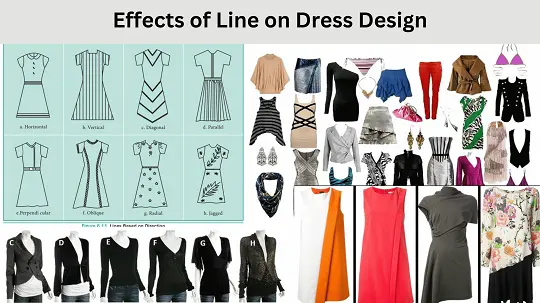Effects of Line on Dress Design
An extension of a point, elongated mark, connection between two points, the effect of the edge of an object. Line is the most basic of the elements of design and is incorporated in many of the other design elements. All lines have length, width, and direction. The line can – direct the gaze of the viewer. – divide the area of the design – apply psychological aspects to the design – generate optical illusion. Every line has length, thickness, and direction. In this article, we discuss on the Effects of Line on Dress Design.
Lines used by fashion experts to create their designs. There are used curve, horizontal, vertical, diagonal, zigzag, wavy, parallel, dash, and dotted lines. In a fashion garment line is achieved with seams, pleats, pin tucks, drapes, decorative trim, and the clever use of design principles. One of the basic components of design, lines are essential in determining the impact and beauty of clothing. Fashion designers can produce a range of effects by deliberately combining different sorts of lines, such as expressing a sense of movement and dynamism or generating illusions of height and slenderness. There are many Effects of Line on Dress Design, here in the following.

Types of line on Dress Design:
- Horizontal line
- Vertical line
- Diagonal or oblique line
- Curve line
- Broken line
- V-shaped line
Some of the effects of the line are shown below:
1. Horizontal line:
Run crosswise and usually widen or shorten the figure. They will make a figure broader. Physical and Psychological effects of line: Horizontal lines are restful, yield to gravity, create quiet, repose, passivity, calmness, or serenity. Horizontal lines imply peace and tranquility, whereas vertical lines can imply firmness, stability, and strength. Many people connect curves with elegance and femininity.
2. Vertical line:
Lead the eye up and down. They usually lengthen or slenderize a figure. Physical and Psychological effects of line: Vertical lines are awake, alert, defy gravity, rigid, firm, stable, and strong. Physical and Psychological effects of line: Vertical lines are awake, alert, defy gravity, rigid, firm, stable, and strong.
3. Diagonal or oblique line:
All starting lines. They may slenderize or break a figure. If they are more vertical, they lengthen, and if more horizontal they break the figure. diagonal or oblique lines will take away some width and give a little height. Physical and Psychological effects of line: Diagonal lines appear undecided, unstable, busy, active, dynamic, restless, dramatic, sporty, lengthening, and reduce horizontal or vertical shapes.
- Often a diagonal line needs an opposing diagonal to appear balanced.
- If diagonal lines are pointing down they tend to lift up, or make the object /wearer appear lighter, happier, and more youthful.
- If they are pointing up the lines will have the opposite effect causing the object/wearer to appear older, heavier, somber, or droopy.
4. Curve line:
Curve lines gives an effect of roundness and tend to broaden. They add gracefulness and are softer. Physical and Psychological effects of line: Physical effects: Slightly emphasizes curve, counter thinness and angularity. Psychological effects: Soft, gentle, flexible but controlled, graceful, dynamic, feminine, unrestrained, youthful, flowing, passive, active, forceful, unstable.
5. Broken line:
Shorten the lengthy straight lines. Physical and Psychological effects of line:
Physical effects: May emphasize irregularities.
Psychological effects: Less certain, interrupted, casual, sporty, playful.Broken line
6. V-shaped line:
V-shaped lines both widen and slenderized. The deeper the V, the more slender the effect.
Designers may make clothes that are not only visually beautiful but also fit the wearer’s body type and personal style by knowing the Effects of Line on Dress Design.
